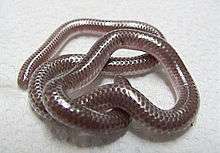Leptotyphlops dulcis
| Leptotyphlops dulcis | |
|---|---|
 | |
| Scientific classification | |
| Kingdom: | Animalia |
| Phylum: | Chordata |
| Subphylum: | Vertebrata |
| Class: | Reptilia |
| Order: | Squamata |
| Suborder: | Serpentes |
| Family: | Leptotyphlopidae |
| Genus: | Leptotyphlops |
| Species: | L. dulcis |
| Binomial name | |
| Leptotyphlops dulcis (Baird & Girard, 1853) | |
| Synonyms | |
| |
Leptotyphlops dulcis is a blind snake species endemic to the southwestern United States and northern Mexico. Three subspecies are currently recognized, including the nominate subspecies described here.[2]
Description
Texas blind snakes appear much like a shiny earthworms. They are pinkish-brown (puce) in color with a deep sheen to their scales. They appear not to be segmented. Their eyes are no more than two dark dots under the head's scales. Their mouths are small and set in an underbite.
Adults can grow to approximately 27 cm (11 in) in total length, including the tail.[3]
On the top of the head, between the ocular scales, L. dulcis has three scales (L. humilis has one scale).[3]
Behavior
Texas blind snakes spend the vast majority of their time buried in loose soil, only emerging to feed or when it rains and their habitat floods with water. Blind snakes are often found after spring rains and mistaken for earthworms. If handled they usually squirm around and try to poke the tip of their tail into the handler. This is a completely harmless maneuver and likely serves as a distractive measure. Their mouths are far too small to effectively bite a human being.
Diet
The diet of L. dulcis consists primarily of termite and ant larvae.
Common names
Common names for L. dulcis include the following: burrowing snake,[4] eastern worm snake,[4] plains blind snake, Texas blind snake, Texas Rena,[4] Texas slender blind snake, Texas threadsnake,[2] Texas worm snake,[4] worm snake.[4]
Subspecies
| Subspecies[2] | Authority[2] | Common name | Geographic range |
|---|---|---|---|
| L. d. dissectus | (Cope, 1896) | New Mexico blind snake | |
| L. d. dulcis | (Baird & Girard, 1853) | Plains blind snake | |
| L. d. myopicus | (Garman, 1884) | ||
Geographic range
L. dulcis is found in the southwestern United States and northern Mexico. In the USA it occurs in southwestern Kansas, western Oklahoma including the panhandle, central & south Texas west through southern New Mexico to southeastern Arizona. In northern Mexico it has been reported in Chihuahua, Coahuila, Tamaulipas, Nuevo León, San Luis Potosí, Veracruz, Querétaro, Hidalgo and Puebla. The type locality given is "Between San Pedro and Camanche Springs Tex." (Comanche Springs, Texas).[1]
Conservation
Gauging wild blind snake populations is virtually impossible due to their secretive nature. However, like many other native Texas species, L. dulcis is known to be detrimentally affected by the red imported fire ant.
See also
- List of leptotyphlopid species and subspecies.
- Leptotyphlopidae by common name.
- Leptotyphlopidae by taxonomic synonyms.
References
- 1 2 McDiarmid RW, Campbell JA, Touré T. 1999. Snake Species of the World: A Taxonomic and Geographic Reference, Volume 1. Washington, District of Columbia: Herpetologists' League. 511 pp. ISBN 1-893777-00-6 (series). ISBN 1-893777-01-4 (volume).
- 1 2 3 4 5 "Leptotyphlops dulcis". Integrated Taxonomic Information System. Retrieved 30 August 2007.
- 1 2 Smith HM, Brodie ED Jr. 1982. Reptiles of North America: A Guide to Field Identification. New York: Golden Press. 240 pp. ISBN 0-307-13666-3. (Leptotyphlops, pp. 136-137).
- 1 2 3 4 5 Wright AH, Wright AA. 1957. Handbook of Snakes of the United States and Canada. Ithaca and London: Comstock. 1,105 pp. (in 2 volumes). (Leptotyphlops dulcis, pp. 39-44, Figure 10, Map 7).
Further reading
- Baird SF, Girard CF. 1853. Catalogue of North American Reptiles in the Museum of the Smithsonian Institution. Part I.—Serpents. Washington, District of Columbia: Smithsonian Institution. xvi + 172 pp. (Rena dulcis, new species, pp. 142–143).
- Behler JL, King FW. 1979. The Audubon Society Field Guide to North American Reptiles and Amphibians. New York: Alfred A. Knopf. 743 pp. ISBN 0-394-50824-6. (Leptotyphlops dulcis, pp. 583–584 + Plate 464).
- Boulenger GA. 1893. Catalogue of the Snakes in the British Museum (Natural History). Volume I., Containing the Families ... Glauconidæ ... London: Trustees of the British Museum (Natural History). (Taylor and Francis, printers). xiii + 448 pp. + Plates I-XXVIII. (Glauconia dulcis, p. 65).
- Conant R. 1975. A Field Guide to Reptiles and Amphibians of Eastern and Central North America, Second Edition. Boston: Houghton Mifflin. xviii + 429 pp. + Plates 1-48. ISBN 0-395-19979-4 (hardcover), ISBN 0-395-19977-8 (paperback). (Leptotyphlops dulcis, pp. 137–138, Figure 31 + Plate 33 + Map 122).
- Klauber LM. 1940. The Worm Snakes of the Genus Leptotyphlops in the United States and northern Mexico. Trans. San Diego Soc. Nat. Hist. 9: 87-162.
- Schmidt KP, Davis DD. 1941. Field Book of Snakes of the United States and Canada. New York: G.P. Putnam's Sons. 365 pp. (Leptotyphlops dulcis, pp. 93–94).
- Stebbins RC. 2003. A Field Guide to Western Reptiles and Amphibians, Third Edition. The Peterson Field Guide Series ®. Boston and New York: Houghton Mifflin. xiii + 533 pp. ISBN 978-0-395-98272-3. (Leptotyphlops dulcis, p. 341 + Figure 19 on p. 118 + Map 128).
External links
 Media related to Leptotyphlops dulcis at Wikimedia Commons
Media related to Leptotyphlops dulcis at Wikimedia Commons- Leptotyphlops dulcis at the Reptarium.cz Reptile Database. Accessed 30 August 2007.
- Leptotyphlops dulcis, Texas Blind Snake at DigiMorph.
- Leptotyphlops dulcis at Life is Short but Snakes are Long